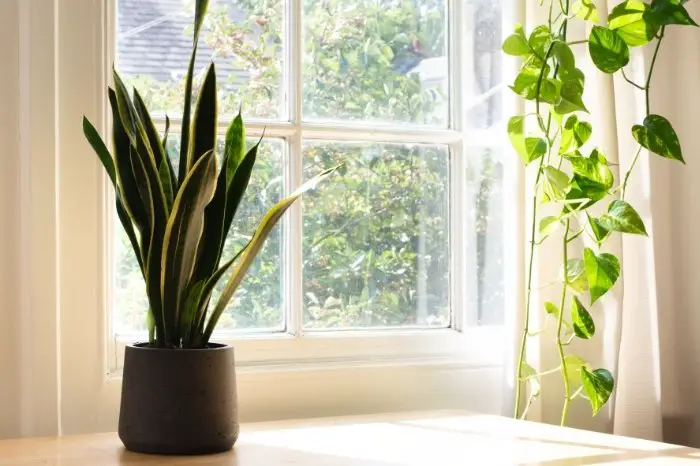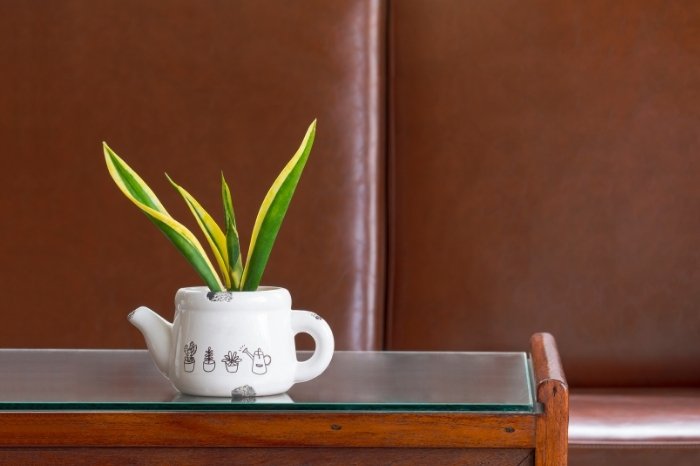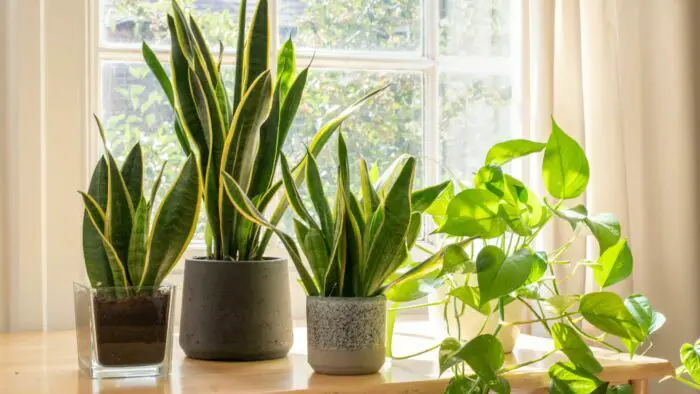Last Updated on April 6, 2023 by Griselda M.
Snake plant temperature tolerance is an essential aspect to know before growing this plant to provide the right growing atmosphere.
The Sansevieria trifasciata, or snake plant, is a hardy and durable plant that can survive in varying temperatures and conditions.
It is one of the plants quickly becoming a favorite among many plant owners. This is due to its sleek, upright leaves and firm nature.
Snake plant temperature tolerance is a common issue that many gardeners face. This guide will enlighten you on the kind of temperature these plants prefer!
Snake Plant Temperature Tolerance
Snake plant is tolerant to a wide range of temperatures; however, they cannot withstand certain weather conditions. Its hardiness allows it to survive in different atmospheric temperatures, but Sansevieria’s cold tolerance is low because it is sensitive to extreme cold weather.
Because this plant is a tropical plant, it is very sensitive to cold temperatures. During winter, keep them in a warm room away from drafty doors and windows. Temperatures below 50°F will destroy or kill these plants.
During the winter months, snake plants can survive in temperatures of 45 degrees F. The soil must be dry in the winter season; if the soil is damp, you should stop watering it until it is dry again. Damp soil causes root rot that can completely destroy your plant. During the winter season, you will need to increase your indoor temperatures to maintain them.

This plant is native to Africa’s dry regions and can survive with average soil, no fertilizers, less water, and low light. Optimum growing temperatures facilitate processes in the plant to help sustain its life. Lesser ideal temperatures usually stunt the plant growth or, in some cases, ruin the plant completely.
In summer, the snake plant will tolerate temperatures as high as 104°F with perfect temperatures ranging between 70 to 90°F, which are excellent for the growth of the plant. You can create this kind of atmosphere in your home or greenhouse.
Read more about Why Does My Aloe Plant Not Stand Up?
Is Snake Plant an Indoor Or Outdoor Plant?
Snake plants can grow both indoors and outdoors alike. Let’s look at how each atmosphere works for this plant.
How to grow snake plants outdoors
If you live in USDA zones 9 through 11, you can grow sansevieria outdoors. These plants are easy to grow but tough, withstanding challenging growing areas. The one non-negotiable requirement is proper soil drainage. If these plants are overwatered or planted in a wet area, they will rot and die. Their preference for dry soil makes them excellent plants for desert or xeriscape landscapes. Their leaves have thick cuticles preventing them from drying out in arid conditions.
The snake plant thrives under the full sun; however, it will grow in light to moderate shade. Too little light can result in weak, spindly plants.
Snake Plant Soil Mix, Specially Formulated for Sansevieria Trifascatia Zeylanica Plants
Growing snake plants indoors
Most plant lovers grow Sansevieria as houseplants. They adapt well to life indoors, where light levels can be lower than outdoors. This plant thrives in a sunny spot, but even a room with little sunlight is suitable.
Use potting soil the same as the one used for cacti, or add coarse sand to regular potting soil to provide the proper drainage that these plants require.
Watering should be done accurately, allowing the soil to dry out slightly between one watering and another.
Choose a container made from clay because clay is porous, so the soil dries more quickly than in a plastic pot. Plastic pots contain too much moisture, which is great for plants that require moist soil. However, in plants like snake plants, plastic pots cause root rot.
Snake plants are tough plants, but two things will surely kill them: too much water or no water at all.
These plants quickly outgrow or even break their containers. To contain their growth, divide and repot them annually using a container that is shallow and wide. Snake plants have a very shallow root system, and in case the soil at the bottom of a deeper container retains moisture, it may encourage root rot. You will require less soil so that it will dry out between watering.
Carry out your repotting in the spring. When repotting, use a balanced fertilizer, 10-10-10 or 8-8-8, diluted to half strength. You can fertilize again towards the end of the growing season in August. Do not fertilize the plants during the winter when they are resting and not actively growing.
Snake Plant Temperature Tolerance – Can Snake Plants Be Left Outside?
Snake plants thrive in both indoor and outdoor growing conditions. However, some of the growing conditions can be too harsh for snake plants, especially if you live in a tropical region.
Even though they can withstand the sun, direct sunlight can be too harsh. Indirect sunlight is ideal for this plant. The weather conditions are not the same throughout the year, so depending on the climate, you can place your plant by the window during the summer. This way, the plants get a few hours of sun. During winter, keep your snake plants inside a well-lit room
Click here to learn about:
Can Snake Plants Survive in an Air-Conditioned Room?
Snake plant is one of the plants that do well in an air-conditioned room with controlled humidity and temperature levels. It is a tropical plant that can withstand drought as well as make an ideal indoor plant. It does not require direct light and needs to be watered at least once per week.

Can Snake Plants Survive Without Sunlight?
All plants rely on light as a source of energy. Snake plants like bright light with only a few hours of direct sun. However, they don’t require sunlight in particular. Any source of light, including house lamps, indirect sunlight, and LED lights, works great.
Find more information about A Detailed Guide For Snake Plant New Shoots
How to Take Care of a Snake Plant?
Many people don’t know how to take care of a snake plant. A lack of knowledge, in this instance, can have detrimental results if your plant is not properly maintained. Although snake plants are not very demanding, they do have their likes and dislikes, just as all plants do. Therefore, if you have a snake plant growing in your garden, you must understand what keeps your plant healthy and happy.
Snake plants are a popular choice for both indoor and outdoor environments because they are very low maintenance. To grow them and keep them thriving, take heed of the information below.
Tips for snake plant care:
Tip 1: Preferred areas
Aside from the snake plant temperature tolerance, these plants thrive in well-lit areas. Therefore, ample sunlight is good for keeping them healthy and happy.
Tip 2: Watering
It is vital to understand that snake plans have a preference for a lack of water. For this reason, overwatering should be avoided.
Tip 3: Drainage
Ensure that the moisture drains away efficiently when watering, as sitting water would result in rotted roots.
Tip 4: Winter care
During the winter season, snake plants should be fed water only once per month.
Tip 5: Sunlight
If your region doesn’t receive an abundance of sunlight, these resilient plants can tolerate some shade. However, extended periods of shade are not recommended if you hope to keep them growing. For growth and flowering purposes, the maximum light exposure that snake plants can tolerate is best.
Tip 6: Temperature
Snake plants do well in temperatures that range from 60 F to 85 F.
Tip 7: Fertilize
Fertilization during the growing season should be a part of your snake plants’ care and maintenance schedule, as it keeps them thriving.
Snake Plant Growing Season
A snake plant growing season starts from the spring season and continues to the summer season. During this time, it is vital to water and fertilizes the plant for proliferation purposes. Snake plants are renowned for their resilience and can endure a variety of growth circumstances. This includes various seasons and the elements they’re exposed to, even during the growing season.
Even though their growing period is precise, you would be glad to know that snake plants can flourish throughout the year in the right conditions. However, the warmer it is outside, the better it is for your snake plants to continue growing. It is advisable to give your snake plants extra water and nutrients to promote wholesome growth during their active period.
Keep in mind that if your plant is exposed to temperatures lower than 50 F, its growth capabilities will be heavily flawed. Therefore, the best way to keep them thriving is by implementing proper care and upkeep during the growing season. Other than that, these resilient plants do well even when left to fend for themselves.
How Tall Does a Snake Plant Get?
Ever wondered how tall a snake plant gets? Let me enlighten you! Snake plants can reach heights of up to several feet and are fondly recognized for their tall upright growth habit. Depending on the plant variety that you’re growing and the environment it is afforded, these vital elements can alter the height that they grow to very much. This is because proper care and the correct environment usually result in snake plants growing much taller than expected.
For example, the Sansevieria Trifasciata, which is the most popular type of snake plant, is known to reach heights of over four feet. But, there are also dwarf varieties that grow to about a maximum height of one or two feet. Another thing to take into consideration when it comes to the height of your snake plant is its capability to reach for the sky.
Given that these hardy plants have the potential to develop quite a substantial root system, giving them enough room to expand is essential. To regulate and enhance the size of a snake plant, it is advisable to water and prune your plant regularly. These gestures will also aid in steadying your plant’s overall structure.
Conclusion
Snake plant temperature tolerance is far better than other plants. They can tolerate harsh growing conditions than most plants and still thrive.
If you are looking to grow this plant, you have full information on the kind of growing conditions that favor this plant. In both winter and summer, you will have the privilege to grow this plant both outdoors and indoors, which is unlikely for most other plants.
Caroline is a gardener who loves to get down to the nitty–gritty of gardening. She proudly proclaims herself as a ‘dirt worshipper‘ and can often be found deep in the garden, covered in soil and singing to her plants. As a self–proclaimed ‘plant whisperer‘, Caroline believes that plants need love and attention just like any other living thing, and she loves to give them both. When she‘s not tending to her garden, you can often find her researching the latest gardening trends, or teaching others how to make their gardens thrive




